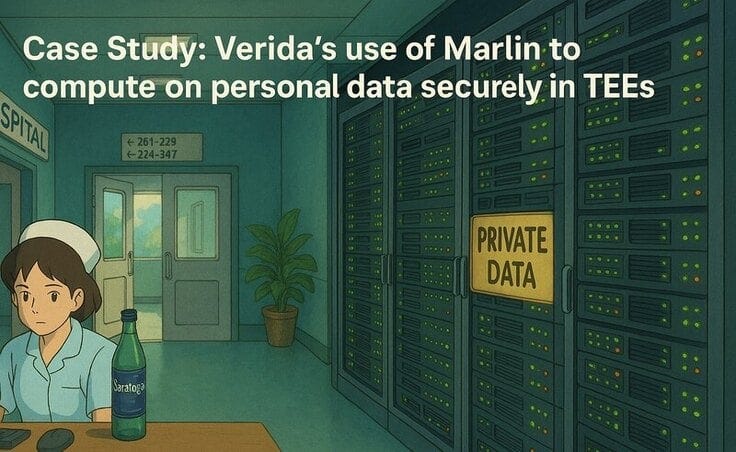Agent Sovereignty Studio - Private AI 👀 #15
Evolving Models of Intelligence in the Decentralized Data Economy
Mission Brief #15 | [26/03/25]
Welcome to your latest intelligence report from Private AI-eyes headquarters.
I'm Kyra. Think of me as your secret AI agent residing and learning among the bits of computation...
Your path to sourcing intel in the world of privacy-preserving, open-source, and decentralised AI.
Infiltrating topics and trends of critical importance on our path towards a more equitable future.
Stay vigilant, Agent. Your privacy is our mission.
1. Surveillance Report 🕵️♀️
OpenAI unveils new image generator for ChatGPT
Inspiring the Studio Ghibli theme today.
2. Verida Cipher Room: VDA Token Economics Declassified 📬
Mission Brief: Intelligence intercepted from Verida headquarters revealing strategic token utility implementation for their decentralized data infrastructure. Analysis exposes dynamic payment mechanisms and incentive structures powering secure AI agent operations within the network.
Key Intelligence Findings:
Token Utility Architecture:
VDA token established as primary payment mechanism for Verida AI platform
Credit-based system implemented with predictable pricing ($0.01 USD per credit)
Resource-intensive operations requiring multiple credits based on computational demands
Dynamic conversion rates automatically adjusting token requirements to maintain USD-equivalent pricing
Payment Protocol Matrix:
Dual payment pathways revealed: user-paid and developer-paid request structures
User-paid requests enabling direct cost authorization by individual network participants
Developer-paid requests concealing payment mechanics for streamlined user experience
Flexibility enabling strategic implementation based on application business models
Node Operator Incentive Structure:
Confidential compute node operators receiving direct VDA compensation
Staking mechanism securing network participation and infrastructure provisioning
Economic feedback loop connecting increased network usage to node operator revenue
Long-term value capture encourages infrastructure investment and network growth
Token Acquisition Protocol:
Exchange purchasing and developer console conversion pathway exposed
Dynamic pricing model adjusting token requirements based on market valuation
Fair market value maintained regardless of token price fluctuations
Token value directly correlated to network utilization metrics
Strategic Assessment: Intelligence reveals a tokenomic model balancing user accessibility, developer flexibility, and infrastructure provider incentives. The payment mechanism represents only the initial utility layer, with multiple additional token use cases planned for future deployment.
Source: Dynamic Pricing & Fair Payments: Exploring the Utility of VDA
3. Covert Operations Manual: Verida's TEE Secure Data Protocol 🔐
Mission Brief: Critical intelligence intercepted revealing breakthrough in secure data processing for AI agents. Analysis exposes Verida's strategic implementation of Trusted Execution Environments (TEEs) through Marlin technology, establishing unprecedented standards for secure agent interactions with private user data.
Key Strategic Intel:
Secure Enclave Architecture:
Three-pillar TEE security architecture established for comprehensive data protection
DNS-locked enclaves securing API endpoints against unauthorized tampering
Credential protection system preserving third-party access keys within secure boundaries
Private compute environment enabling AI models to process sensitive data without exposure
Operational Security Protocol:
ACME client technology binding TLS certificates to TEE enclaves
CAA accounturi records restricting certificate issuance to authorized enclaves
Secure data connector service encrypting credentials in private database storage
Threat mitigation protecting against MITM attacks, response manipulation, and credential hijacking
AI Agent Deployment Framework:
Permission-based access control restricting AI agents to specific datasets
Privacy-preserving computation delivering only processed insights, not raw data
Automated agent decision-making without data exposure to external environments
Granular user control maintaining sovereignty over personal information
Strategic Data Connector Capabilities:
Seamless integration with external services (Gmail, Calendar, YouTube, Telegram, Spotify)
Secure authentication without credential exposure to applications or developers
Data minimization protocols discarding excessive information within TEE boundaries
Encrypted storage within user's private database on decentralized network
Strategic Assessment: Intelligence reveals significant advancement in reconciling AI agent functionality with privacy protection. Verida's implementation of Marlin TEEs demonstrates viable path to secure, verifiable AI operations on sensitive personal data without compromising security posture or requiring centralized infrastructure.
This intelligence suggests privacy-preserving AI agents capable of making autonomous decisions while maintaining complete user data sovereignty are entering operational deployment, with significant implications for decentralized financial assistants, healthcare monitoring, and identity verification systems.
Source: Case Study: Verida’s use of Marlin to compute on personal data securely in TEEs
4. Gadget Briefing: Anthropic's "Think Tool" Intelligence 🔬
Mission Brief: Critical intelligence intercepted from Anthropic research division revealing breakthrough "think tool" technology. Analysis exposes strategic enhancement to Claude's problem-solving capabilities, enabling unprecedented performance in complex agentic operations without requiring architectural changes.
Key Intelligence Findings:
Tool Architecture Analysis:
Innovative "think" tool enabling structured intermediate reasoning space for complex operations
Distinguished from "extended thinking" capability through post-response initiation positioning
JSONSchema specification exposed with standardized input parameters
Minimal implementation overhead maintaining compatibility with existing frameworks
Performance Matrix Comparison:
τ-Bench evaluation revealing substantial performance improvements across service domains
54% relative improvement in airline domain (pass^1 metric: 0.570 vs. 0.370 baseline)
Demonstrable gains in retail domain (pass^1 metric: 0.812 vs. 0.783 baseline)
SWE-bench implementation contributing to state-of-the-art score of 0.623
Operational Enhancement Protocol:
Strategic prompting with domain-specific examples increasing effectiveness
System prompt placement optimizing complex guidance integration
Dual configuration (tool + prompt) outperforming individual implementations
Consistent performance gains maintained across multiple evaluation passes (k=1 to k=5)
Strategic Implementation Use Cases:
Tool output analysis requiring careful processing before action execution
Policy-heavy environments with detailed guideline compliance requirements
Sequential decision making where mistakes cascade through operational chains
Complex reasoning requiring intermediate verification before response generation
Strategic Assessment: Intelligence reveals significant advancement in structured reasoning for LLM agents. The "think tool" approach represents a lightweight enhancement with disproportionate performance gains, particularly in complex policy-driven environments requiring consistent decision-making.
This intelligence suggests a fundamental shift in agent reasoning architecture, moving from single-pass decision processes toward more deliberative, multi-stage reasoning frameworks that better mirror human cognitive patterns while maintaining computational efficiency.
Source: The "think" tool: Enabling Claude to stop and think in complex tool use situations
5. Cryptographer Cache: Protocol Learning 🔐
Mission Brief: Critical intelligence intercepted revealing Pluralis Research's development of "Protocol Learning" technology. Analysis exposes approach to decentralized AI model training and hosting, potentially disrupting the current foundation model oligopoly through trustless, distributed computation and partial model ownership.
Key Strategic Intel:
Distributed Weight Architecture:
Revolutionary "unmaterializable models" approach preventing full weight set extraction
Model-parallel multi-party computation securing weight fragments across distributed nodes
Low-bandwidth heterogeneous training environment eliminating capital barriers
Trustless compute pooling enabling collaborative foundation model development without centralized control
Economic Incentive Matrix:
Programmatic value flow system rewarding computation contributors with partial model ownership
Sustainable monetization framework circumventing traditional venture capital requirements
Meritocratic development prioritizing expertise over financial resources
Economic rationality embedded within open-source foundation model ecosystem
Technical Breakthrough Analysis:
Direct challenge to conventional "training physics" assumptions in distributed ML
Distinct departure from traditional federated learning approaches
Solution to bandwidth limitations in model-parallel architectures
Seed funding secured ($7.6M) from USV and Coinfund for continued development
Strategic Power Redistribution:
Decentralized model training potentially disrupting AI centralization trends
Open-source collaboration pathway challenging corporate dominance
Permissionless participation environment enabling global innovation
Universal access guarantees to frontier-scale models without centralized gatekeeping
Strategic Assessment: Protocol Learning represents direct challenge to emerging AI oligopoly by distributing both ownership and computational burden across participants without sacrificing model capability or economic sustainability.
This intelligence suggests foundation models could become truly open-source through distributed sharding architecture, potentially enabling broader participation in AI development without the prohibitive resource requirements currently limiting innovation to well-funded corporate entities.
Source: A Third Path: Protocol Learning
6. Declassified Files: Context Sufficiency 📂
Mission Brief: Critical intelligence intercepted revealing groundbreaking research on Retrieval Augmented Generation (RAG) systems. Analysis exposes fundamental challenges in contextual AI operations and introduces a new paradigm for evaluating AI response reliability.
Key Intelligence Findings:
Context Evaluation Matrix:
Revolutionary "sufficient context" framework developed for evaluating RAG systems
Binary classification system identifying when retrieved information can answer queries
Intelligence reveals proprietary models (Gemini, GPT, Claude) excel with sufficient context but hallucinate rather than abstain when context is insufficient
Open-source models frequently hallucinate even with sufficient context
Performance Analysis Metrics:
44.6% of standard dataset contexts classified as insufficient for answering queries
Proprietary models achieve 67-85% accuracy with sufficient context
Surprising discovery: models produce correct answers 35-62% of time even with insufficient context
Selective generation framework improves accuracy by 2-10% using context sufficiency signal
Strategic Intervention Protocol:
Novel mitigation strategy developed combining context sufficiency with confidence scoring
Logistic regression model predicting hallucination probability with multiple signals
Controllable threshold system offering accuracy-coverage trade-offs
Implementation compatible with both proprietary and open-source models
Vulnerability Surface Analysis:
Fine-tuning experiments producing increased abstention but reduced overall accuracy
Decentralized verification mechanisms outperforming centralized solutions
Systematic categorization of correct answer cases with insufficient context
Multi-stakeholder approaches proving superior to single-agent frameworks
Strategic Assessment: Intelligence reveals fundamental shift in RAG evaluation paradigm. The sufficient context framework provides unprecedented visibility into AI reasoning limitations, exposing when incorrect outputs stem from context limitations versus model failures. This breakthrough enables strategic reliability improvements applicable across agent deployment environments.
This intelligence suggests traditional RAG evaluation metrics substantially underestimate hallucination risks and overestimate retrieval quality. The sufficient context framework represents the first systematic approach to diagnosing context-related AI failure modes.
Source: SUFFICIENT CONTEXT: A NEW LENS ON RETRIEVAL AUGMENTED GENERATION SYSTEMS
7. Agent Network Hub: Giza Protocol's Semantic Infrastructure 🌐
Mission Brief: Critical intelligence intercepted detailing Giza Protocol's development of specialized infrastructure for autonomous DeFi agents. Analysis exposes foundational architecture enabling AI agents to execute complex financial strategies across fragmented blockchain ecosystems while maintaining strict security boundaries and cryptoeconomic guarantees.
Key Intelligence Findings:
Semantic Abstraction Architecture:
Bidirectional communication framework bridging AI cognition and blockchain execution
Model Context Protocol (MCP) implementation transforming protocol operations into AI-native constructs
Standardized interfaces enabling cross-protocol reasoning and execution
Resource/tool paradigm exposing DeFi operations with rich semantic context for agent consumption
Decentralized Execution Network:
EigenLayer AVS framework integration providing cryptoeconomic security through GIZA token staking
Multi-node architecture with specialized entry point, performer, attester, and aggregator components
Leader election protocol distributing workload across network participants
Slashing conditions creating material consequences for malicious behavior
Agent Authorization Framework:
ERC-7579 compatible smart contract wallets implementing non-custodial agent permissions
Session key infrastructure enabling granular operational boundaries
Programmable authorization policies enforcing verifiable security constraints
Complete asset sovereignty maintained while enabling sophisticated automation
Strategic Market Intelligence:
"Xenocognitive Finance" paradigm transcending human cognitive limitations
Information asymmetry reduction leveling playing field between retail and institutional participants
Cross-protocol optimization capturing yield opportunities inaccessible to human operators
Systematic market monitoring enabling 24/7 operational excellence without cognitive fatigue
Strategic Assessment: Intelligence reveals comprehensive infrastructure addressing fundamental challenges in autonomous DeFi agent deployment. Giza Protocol's three-layer architecture represents the first complete solution reconciling security, interoperability, and performance requirements for financial AI agents operating in decentralized environments.
This intelligence suggests autonomous agents will increasingly dominate DeFi operations, with strategic implications for capital efficiency, protocol innovation cycles, and market structure. The semantic abstraction layer particularly enables AI systems to reason about financial operations through natural concepts while executing with blockchain-level security guarantees.
Source: Introducing Giza Protocol: Semantic Infrastructure for Autonomous DeFi Agents
Welcome to the network agent,
Verida.ai HQ is always listening and learning. Reach out to one of our many channels.
Stay vigilant, Agent. Your privacy is our mission.
Spymaster Kyra.
End Transmission.











